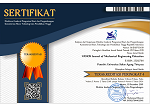Virtual Lab Development to Support Automotive Electrical Practicum Course
Abstract
Throughout 2020, what was implemented at UM had an impact on the learning of practical subjects. Practical learning that has been carried out in laboratories/workshops must switch to an online system. One of them is the Body Electrical Practicum course, 3 credits/6 JS. Due to the nature of courses that are usually carried out by laboratories to provide effective skill acquisition and hands-on experience, it is often difficult to make these laboratories accessible online. Therefore, the solution offered in this research is to develop virtual lab-based learning content to complement the learning content that has been implemented so far. The purpose of this research is (1) to produce appropriate learning media (2) to test the effectiveness of the developed media. This research method uses research and development of the ADDIE model which consists of analysis, design, development, and implementation. Meanwhile, the data analysis used is in the form of a percentage that describes the size of the feasibility of the virtual lab developed according to experts, and the tow tail test is used to test the effectiveness. Based on the feasibility test from the experts that the developed media is suitable for learning in electrical courses in the Department of Mechanical Engineering, State University of Malang with minor revisions. While the results of the effectiveness test show that the media developed is very effective, as evidenced by an increase in the value of the respondents who are the object of the test. The contribution of this research is to complement the offline practical learning that has been carried out so far, so that it can provide solutions for online practicum models during the pandemic.
Keywords
Full Text:
PDFReferences
M. Churiyah, S. Sholikhan, F. Filianti, and D. A. Sakdiyyah, “Indonesia Education Readiness Conducting Distance Learning in Covid-19 Pandemic Situation,” International Journal of Multicultural and Multireligious Understanding, vol. 7, no. 6, p. 491, 2020, doi: 10.18415/ijmmu.v7i6.1833.
J. D. González et al., “Impact of the use of virtual laboratories of electromagnetism in the development of competences in engineering students,” Journal of Physics: Conference Series, vol. 1247, no. 1, 2019, doi: 10.1088/1742-6596/1247/1/012018.
A. Mirçik, Özden; Saka, “Virtual Laboratory Applications in Physics Teaching Journal:,” Canadian Journal of Physics, vol. 7, no. 2, pp. 1–8, 20117.
V. Potkonjak et al., “Virtual laboratories for education in science, technology, and engineering: A review,” Computers and Education, vol. 95, pp. 309–327, 2016, doi: 10.1016/j.compedu.2016.02.002.
A. Rachmat, E. D. Jannati, D. Susandi, I. Kaniawati, and P. Siahaan, “Application of VLAB-Based STEM in the Direct Circuit Electricity Section,” Journal of Physics: Conference Series, vol. 1477, no. 5, 2020, doi: 10.1088/1742-6596/1477/5/052020.
M. D. R. Uribe, A. J. Magana, J. H. Bahk, and A. Shakouri, “Computational simulations as virtual laboratories for online engineering education: A case study in the field of thermoelectricity,” Computer Applications in Engineering Education, vol. 24, no. 3, pp. 428–442, 2016, doi: 10.1002/cae.21721.
K. A. J. Magana et al., “EXPLORING MULTIMEDIA PRINCIPLES FOR SUPPORTING CONCEPTUAL LEARNING OF ELECTRICITY AND MAGNETISM WITH VISUOHAPTIC SIMULATIONS,” The ASEE Computers in Education (CoED) Journal, vol. 8, no. 2, pp. 8–23, 2017.
L. F. Z. Rivera and M. M. L. Petrie, “Models of collaborative remote laboratories and integration with learning environments,” International Journal of Online Engineering, vol. 12, no. 9, pp. 14–21, 2016, doi: 10.3991/ijoe.v12i09.6129.
E. A. N. Fandini, S. Siswandari, and K. Kristiani, “The Impact of Adobe Flash Media on Increasing Students’ Critical Thinking Ability,” International Journal of English Literature and Social Sciences, vol. 6, no. 5, pp. 045–048, 2021, doi: 10.22161/ijels.65.8.
T. Budai and M. Kuczmann, “Towards a modern, integrated virtual laboratory system,” Acta Polytechnica Hungarica, vol. 15, no. 3, pp. 191–204, 2018, doi: 10.12700/APH.15.3.2018.3.11.
J. W. Smith, “Immersive virtual environment technology to supplement environmental perception, preference and behavior research: A review with applications,” International Journal of Environmental Research and Public Health, vol. 12, no. 9, pp. 11486–11505, 2015, doi: 10.3390/ijerph120911486.
L. D. Feisel and A. J. Rosa, “The role of the laboratory in undergraduate engineering education,” Journal of Engineering Education, vol. 94, no. 1, pp. 121–130, 2005, doi: 10.1002/j.2168-9830.2005.tb00833.x.
E. Salmerón-Manzano and F. Manzano-Agugliaro, “The higher education sustainability through virtual laboratories: The Spanish University as case of study,” Sustainability (Switzerland), vol. 10, no. 11, 2018, doi: 10.3390/su10114040.
J. P. Correa-Baena et al., “Accelerating Materials Development via Automation, Machine Learning, and High-Performance Computing,” Joule, vol. 2, no. 8, pp. 1410–1420, 2018, doi: 10.1016/j.joule.2018.05.009.
Z. Zulherman*, G. Amirulloh, A. Purnomo, G. B. Aji, and S. Supriansyah, “Development of Android-Based Millealab Virtual Reality Media in Natural Science Learning,” Jurnal Pendidikan Sains Indonesia, vol. 9, no. 1, pp. 1–10, 2021, doi: 10.24815/jpsi.v9i1.18218.
I. M. Astra, H. Nasbey, and A. Nugraha, “Development of an android application in the form of a simulation lab as learning media for senior high school students,” Eurasia Journal of Mathematics, Science and Technology Education, vol. 11, no. 5, pp. 1081–1088, 2015, doi: 10.12973/eurasia.2015.1376a.
DOI: http://dx.doi.org/10.30870/vanos.v7i1.13190
Refbacks
- There are currently no refbacks.

This work is licensed under a Creative Commons Attribution 4.0 International License.


.png)
.png)
